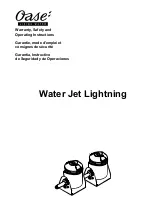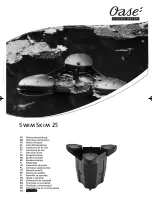
8
!
Connect the ground clamp (42) to the workpiece.
!
Turn the machine on (1).
!
Remove the taper gas nozzle (51) by rotating it
clockwise.
!
Unscrew the contact tip (50).
!
Press the torch push button (46) and release it only
when the wire comes out.
Welding wire can cause puncture wounds.
!
Do not press gun trigger until instructed to do so.
!
Do not point gun toward any part of the body, other
people, or any metal when threading welding wire.
!
Tighten the contact tip (50) and make sure that the
hole diameter corresponds to the wire being used.
!
Reinstall the taper gas welding nozzle (51), rotating it
clockwise.
WARNING: ELECTRIC SHOCK CAN KILL!
!
Do not touch live electrical parts.
!
Do not touch the weld output terminals when the unit is
energised.
!
Do not touch the torch or electrode holder and the
work clamp at the same time.
ATTENTION: The green/yellow wire of the input power
cable must always be connected to the protection lead
(ground of the system). The yellow/green wire must NEVER
be combined with another phase wire for drawing voltage.
2.4 CONNECTING THE GAS HOSE
WARNING: CYLINDERS CAN EXPLODE IF DAMAGED!
!
Keep the cylinders in a place where they cannot be
damaged.
!
Do not lift the machine with the cylinder on its support.
!
Never touch the cylinder with the welding wire.
!
Keep the cylinder away from the welding area and
uninsulated electric circuits.
!
Cylinders containing inert gas have to be equipped
with a regulator and a flowmeter.
!
After having positioned the cylinder, connect the gas
hose that comes out from the rear of machine to the
pressure regulator.
!
Turn the gas cylinder on and adjust the flowmeter to
approx. 8-10 litre/min.
ATTENTION: Make sure that the gas used is compatible
with the material to be welded.
2.5 UNIT DESCRIPTION (Fig.1)
B) Potentiometer for the linear adjustment of the wire
speed.
C) Welding torch connection.
D) Earth cable connection.
E) Voltage adjustment switch.
F) Thermostat pilot light.
G) Main ON/OFF indicator lamp.
H) Electronic spot-welding time or working time adjustment
I) ON-OFF
switch.
L) This knob adjusts the pause time between two welding
intervals.
M) 10-pin connector for PUSH-PULL torch and SPOOL-
GUN torch connection.
2.6 GENERAL NOTES
Before using this welding machine, carefully read the CEI
Standards 26/9 or CENELEC HD 407 AND CEI 26/11 or
CENELEC HD 433, also check for insulation of cables,
torch and earth cable.
3 WELDING GUIDELINES
3.1 CONTINUOUS MILD-STEEL WELDING
75% ARGON + 25% CO
2
or 100% CO
2
can be used for
mild steel welding.
!
Adjust the welding voltage with switch (57).
!
Approach the point to be welded and press the torch
push button (46).
!
Adjust the potentiometer (B fig.1) until the welding
noise is constant and continuous.
If the speed is too high, the wire tends to get stuck on the
workpiece that makes the torch bounce back. If speed is
too low, the wire melts irregularly or else the arc switches
off.
NOTE: To obtain well joined and well shielded weldings
always weld from left to right and from up to down.
At the end of each welding remove the slags.
3.2 ALUMINIUM WELDING
The machine has to be set up as for mild steel except for
the following changes:
!
Use pure Argon as the protection gas.
!
Use a welding wire with a composition suitable for the
base material to be welded.
!
Use mills and brushing machines specifically designed
for aluminium, and never use them for other materials.
!
In order to weld aluminium you must use the torch
PUSH-PULL and SPOOL GUN.
3.3 STAINLESS STEEL WELDING
The machine will be set-up as for mild-steel welding except
for following changes:
!
Use stainless steel wire compatible with the
composition of steel to be welded.
!
Use cylinder containing a mixture of 98% ARGON +
2% O
2
(recommended mixture).
Recommended torch inclination and welding direction are









































